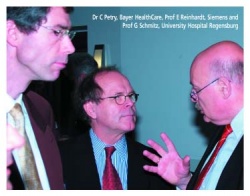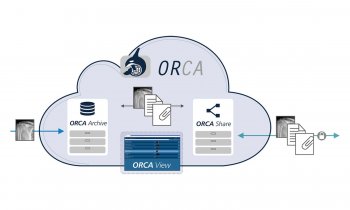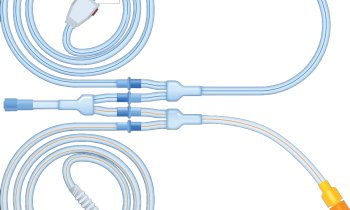The advent of personalised therapies
12 distinguished researchers and industry representatives presented the latest molecular medicine research at the Molecular Medicine - from Diagnostics to Therapy symposium - one in a series of annual diagnostics seminars organised by the Forum Medicine Technology & Pharmaceutics e.V.

The event, held in June, was hosted by Siemens AG (Erlangen, Germany) and opened by Professor Erich R Reinhardt of Siemens and Dr Thomas Feigl, Forum’s Managing Director.
Speaking of communication networks and the potential for customised treatment for individual patients, Professor Gerd Schmitz (University Hospital Regensburg) foresaw that fast, efficient, individualised treatment for each patient will be enhanced by the networking of hospitals, doctors, pharmacies and other players in the health service facilitates, as well as the arrival of the Electronic Health Card *, which stores health-relevant data and prescriptions. The card has already been introduced in several European countries, and is due for introduction in Germany. As the data on the health card has to be networked with bio-banks, this provides opportunities for a comprehensive transfer of knowledge, Prof. Schmitz said. Molecular medicine in particular can profit from that knowledge transfer, because it depends on comprehensive clinical data that can be made accessible for doctors through new technologies available, he pointed out. In the future, it will be possible to compare individual health-related data with comprehensive data parcels gathered from population genetic studies, which should significantly improve our understanding of individual disease patterns. In the future, doctors will be able to use E-Health-Portals as case-related training media, Prof. Schmitz prophesied.
Introducing the subject Molecular imaging – disease-specific imaging, Professor Wolfhard Semmler (German Cancer Research Centre, Heidelberg) emphasised that new imaging procedures will visualise abnormalities on a partly molecular level at an early stage, before morphological or other secondary changes occur. This is of particular importance for those diseases where the chance of a cure depends very much on an early diagnosis (e.g. cancer). Disease-specific markers, or surrogate markers, are used for this purpose.
Describing the early location and evaluation of malignant diseases Dr Sabine Martina Eschmann (University Hospital Tubingen) used images and explanations to introduce features of the new PET/CT. This combination of a PET-scanner and computed tomograph (CT) – mostly a multi-slice CT – is termed hardware-fusion. This combined imaging enables detailed study of the anatomy and function of tumours. PET/CT works faster and is more reliable than existing procedures, avoids doubling up on examinations and reduces ambiguous results, which can occur with the isolated procedures currently in use, she explained, adding that its potential areas of use are manifold, for example staging, i.e. the grading of a tumour by size, etc.
Dr Claus Tempelmann (OvG University, Magdeburg) introduced the first European 7 Tesla Magnetic Resonance Tomograph. Apart from being affected by the high levels of noise caused by the 7 Tesla-Magnetic Resonance Tomograph, some people developed dizziness and a metallic taste in their mouths. However, these adverse effects can be limited by using headphones and sound absorbing measures, as well as by guiding patients into the scanner very slowly. The scanner facilitates high resolution, structural measurements with spatial solution of less than half a millimetre, which allows, for example, the visualisation of Alzheimer’s plaques in the brain.
Speaking of the connection between personalised medicine and molecular diagnostics, Dr Christoph Petry (Bayer HealthCare LLC, Leverkusen) pointed out that molecular diagnostic analysis is of particular importance in breast cancer treatment – to improve and individualise the choice of available therapies. The choice of predictive tests to determine the likelihood of relapses is a key area, because data that become available through these procedures can be used to develop effective therapies. Bayer Healthcare Diagnostics is working on an array technology that facilitates direct detection of DNA and RNA without the need for prior amplification, he said, which means that diagnostic tests can be carried out effectively and made parallel within the context of personalised medicine. Using micro arrays, researchers will be able to screen a sample onto thousands of genes at the same time. Patients’ genetic dispositions can be automated and standardised with the help of arrays, which could contribute to individualised therapy.
Further opportunities presented by micro-array technology were presented by Dr Mathias Prucha (Affymetrix GmbH, Langenau), who explained that molecular causes of diseases such as diabetes, or arteriosclerosis, could be quickly and precisely identified due to enormous progress in resequencing on arrays.
Dr Gerald Schock (QIAGEN GmbH, Hilden) said that the problems with carrying out amplifications, caused by insufficient amounts of DNA, would soon be overcome. Introducing a new procedure, called Whole Genome Amplification (WGA), he said that this kind of amplification of genetic material offers consistent duplication with low error rates, which enables the immediate use of DNA in gene tests, without first having to determine and adapt the amount of DNA to be used.
Dr Thomas Rygus (Applied Biosystems Europe, Darmstadt) discussed Integrated Gene Expression Analysis – the use of DNA micro arrays and new alternatives in data interpretation. Lab-on-a-chip technology represents a significant advance for molecular diagnostics. The new technology, introduced by Dr Walter Gumbrecht (Siemens AG, Erlangen), a winner of the German Future Award 2004, carries out human DNA examinations, yet the lab system is contained only in plates the size of credit cards. A drop of blood or other body fluid can be duplicated and analysed through amplification.
Professor Ivar Roots (Institute for Clinical Pharmacology, Charité, Berlin, highlighted the influence of genetic predispositions on drug effects – the basic principle of pharmacogenetics, a key to individually customising drug dosage and frequency for patients. Professor Roots is focusing on this using his CENiMED spin-off.
Dr Andreas Görtz (Roche Diagnostics GmbH, Mannheim) introduced the firm’s new AmpliChip 450 test, a significant step, he said, on the way to personalising medicine. The chip helps to quickly determine a patient’s metabolism and ascertain how that body might tolerate drugs.
Representing Professor Bernhard Wolf (Technical University, Munich) Dr Martin Brischwein, spoke of possibilities for bio-electric chips for diagnosis and high-throughput-screening – a project that could one day be used for tumour cell cultivation, to examine their sensitivity to different therapies, parallel with actual treatment, to study drug effects.
* The electronic health card will be discussed during a symposium in Nuremberg (7/7/05), also organised by Forum Medicine Technology & Pharmaceutics e.V.
07.08.2006









